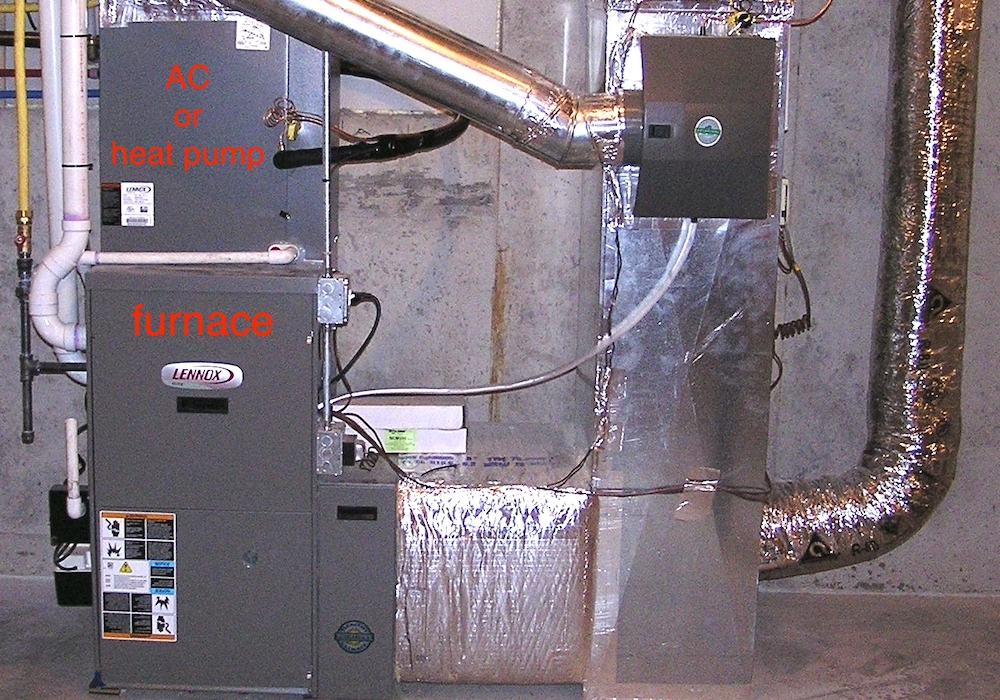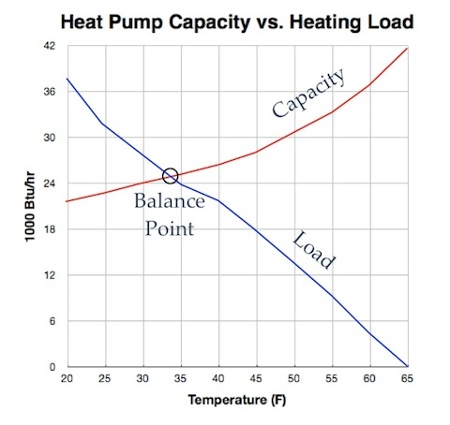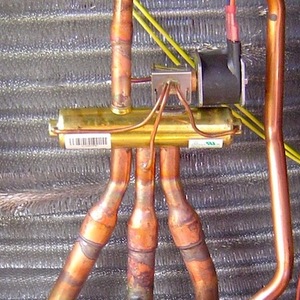
With the Inflation Reduction Act (IRA) rebates and other energy efficiency incentives out there now, it’s a great time to start using a heat pump to heat your home. If you’re currently heating with a furnace and have an air conditioner as part of the system, you have an easy way to switch to a heat pump when you’re ready to replace the AC. Let me introduce you to what’s called a dual fuel heating system (or dual fuel heat pump).
The furnace and air conditioner goes dual fuel
The standard heating and air conditioning system used in many places is a furnace for heating and air conditioner for cooling. Because they use the same air duct system to distribute the heating and cooling, they’re connected. In the photo above and the one just below, you can see them on the left side.

The furnace provides the heating and also the air movement. That’s where the blower that moves the air is located. The indoor part of the air conditioner is the box sitting on top of the furnace. In cooling mode, the blower in the furnace runs but the heating part of the furnace doesn’t operate. The air conditioner also has an outdoor unit, where the compressor and outdoor coil live.
That box sitting above the coil, though, could be part of a heat pump. In either case, it’s the indoor part of a split system AC or heat pump and usually includes the indoor coil and the metering device. The other part of the heat pumping action occurs outdoors. (See my article on how a heat pump gets heat from cold air for more details.)
When it’s time to replace the air conditioner
Back in 2009, I lived in a condo and had to replace the 25-year-old air conditioner. We had a furnace for heating, but I wanted the ability to provide at least some of my heat with a heat pump. (I was already advocating for electrification then but not as much as I do now.) When the air conditioner was dying, I replaced it with a heat pump. I think the additional cost was only $300.
Although the cost difference is higher now, you still have the opportunity to switch to a heat pump when it comes time to replace the air conditioner. And if your AC is more than ten years old, you should be planning for that day. More than 15 years old? It may well be time to make the switch. The IRA and other incentives probably will pay the difference in cost between and AC and heat pump. Depending on where you live, those incentives might even cover more than the AC/heat pump cost difference.
After the switch, you’ll have a dual fuel heat pump. It will use the heat pump in milder weather and switch to the furnace when the outdoor temperature drops to a certain point.
Finding balance
When you switch from an air conditioner to a heat pump and keep your furnace, you now have two heating systems. You still have the furnace, but the heat pump will probably do most of your heating. Above a certain temperature, the heat pump does all the heating. Below that temperature, the heat pump turns off and the furnace takes over.
Ideally, that transition should be at or even a bit below the thermal balance point. Now, the balance point—because I know you’re wondering—is the temperature where an air-coupled heat pump produces just enough heating to meet the heating load of the house.

At outdoor temperatures above the balance point, the heat pump produces more than enough heat and runs by itself. At outdoor temperatures below the balance point, the heat pump can’t heat the house sufficiently. In a straight heat pump system, that usually means there’s some type of auxiliary heat that kicks in and makes up the difference while the heat pump keeps running. In a dual fuel system, though, the heat pump turns off at the setpoint and the furnace comes on.
Pretty simple concept, right? Another way to handle the transition is to set it up so that the system switches from heat pump to furnace at the economic balance point. As it gets colder outdoors, an air-coupled heat pump not only loses capacity but it also drops in efficiency. The economic balance point uses the costs of gas and electricity to switch over when it becomes more economical to heat with the furnace.
Are you ready to switch to a heat pump?
If you need a new air conditioner but your furnace is still in good shape, this is the easy way to switch to a heat pump. The resulting dual fuel heat pump can give you the best of both worlds. It’s a step toward electrification without relying on expensive electric resistance auxiliary heat on those really cold days.
And if you’re brave or foolhardy enough, you could even try locking out the furnace completely so the system runs in heat pump only mode. That’s essentially what I’ve done with my current home, although I have no furnace or auxiliary heat. Here’s how we did in the arctic blast last December. But make sure you know what your heating load is before doing this.
________________________________________________________________________
Allison A. Bailes III, PhD is a speaker, writer, building science consultant, and the founder of Energy Vanguard in Decatur, Georgia. He has a doctorate in physics and is the author of a bestselling book on building science. He also writes the Energy Vanguard Blog. For more updates, you can subscribe to our newsletter and follow him on LinkedIn. Images courtesy of author.
Weekly Newsletter
Get building science and energy efficiency advice, plus special offers, in your inbox.















10 Comments
I replaced an old furnace and air conditioner with a HE Trane furnace and heat pump in Missouri back in 2006. The hp was of course a single stage unit at the time and cost about $1,000 more than an ac. It struggled to heat adequately below freezing, when the furnace would kick in. Unfortunately, the hp burned out in freezing weather after 11 years, just out of warranty. As I would be moving shortly, I took the cheaper option of replacing it with an ac. I compared the cost of running with a heat pump vs. an air conditioner and to my surprise it was about the same, so no savings. I was simply replacing some gas as a fuel with (coal-generated) electricity, so it probably wasn't eco-friendly either. Nonetheless, I went with a dual fuel system again upon moving to the Seattle area, where I think it made more sense because of the change in climate and technological improvements.
I can fully agree that replacing an air conditioner with a heat pump can be a wise move. In Seattle, I had a newer, variable-speed, American Standard furnace and decided to add cooling capacity. The summers have been getting hotter here, and we've had spikes up to 109 degrees (F), but most days are mild. I'd say we need cooling maybe ten days in the year, and mostly in late afternoons, so an air conditioner would be underutilized. It also rarely gets below freezing, so it's an excellent climate for heat pumps as they will do all the cooling and most of the heating. I wanted a variable speed, inverter heat pump, which proved to be a challenge as most of them require the capacity to communicate with the furnace. For AS, that meant a top-of-the-line hp and their most advanced furnace, which I didn't have. I finally discovered the Bosch hp, which met my criteria and will work with most furnaces. The Bosch is also smaller and a lot quieter than my old single-stage Trane heat pump. On the other hand, it would have been simpler and cheaper to buy a more conventional, single-stage heat pump as probably any brand and model would have worked with my furnace. One thing to note, for prospective buyers, is that prices have doubled since the pandemic.
Dual fuel initially looks like a good idea for many cases, though I haven't found it to be practicable (or sensible) for many in CZ4a. The "now" problem is getting an existing furnace to match up with a heat pump for an AHRI certificate that qualifies for the IRA (and perhaps state/local/utility incentives). Of course an unmatched heat pump can be installed, though a $2k tax credit is a lot to leave on the table.
The potential future problem is the furnace at end of life. Assuming that's 10-15 years from now, presumably a new furnace won't go in. Meaning that either an air handler must replace the furnace (with attendant challenges in finding an AHRI match), or the existing heat pump may need to be replaced before end of life.
I'm an energy advisor in Canada. Of course, it's a completely different incentive environment here. But we had a similar issue in that people with furnaces more than a year or two old couldn't find matching heat pumps. If you search the AHRI database and under AHRI type, select "HRCU-A-C" you will find heat pump + coil combinations that "match" with any furnace. Currently, there are over 300 of these that meet the efficiency criteria for our Greener Homes incentive program.
I was simply replacing some gas as a fuel with (coal-generated) electricity, so it probably wasn't eco-friendly either. Nonetheless, I went with a dual fuel system again upon moving to the Seattle area, where I think it made more sense because of the change in climate and technological improvements.
If the economic balance point temperature is colder than the thermal balance point temperature, it would be good to run the heat pump and the gas/propane furnace at the same time (similar to what one would do with electric resistance backup). In order to do that, you would need to put the coil upstream of the furnace. Is it feasible to do this? One heating contractor suggested to me that, when the ASHP is running in cooling mode, it may cause condensation to form on the electronics in the furnace. Is there anything to that? Others have suggested that the controls for the furnaces would not be able to handle that type of setup.
If you’re below the economic balance point, you’re below the point where operating the heat pump makes sense. Regardless where you put the coil, $/BTU will be less from the heat pump than from burning gas, so just turn the HP off and don’t sweat it. ;)
Regarding the coil before the air handler causing condensation issues, I doubt it. Any surface above the dewpoint of the conditioned air will not condense moisture. Not a big issue, but the heat of the fan motor would be added after the coil, slightly reducing cooling capacity; a 600W fan motor would reduce cooling by almost 2kBTU.
Sorry I wasn't clear. I'm talking about temperatures between the thermal balance point temperature (tBPT) and the economic balance point temperature (eBPT) when the eBPT is below the tBPT. That is, temperatures at which it still makes economic sense to run the heat pump but you need supplemental heat.
would it not make more sense to put the hp condenser before the furnace? you want the hp to have the low supply temp. for best COP, the furnace can then go up to the required final temp. Ok - you miss some condensing (if it is a condensing furnace) but this is secondary for me.
edit: actually that makes control simple. The hp will just fall behind when its getting could outside. The furnace will kick in automatically if that happens, these two units do not actually need to talk to each other.
Thank you! This is exactly what I would like to do to my existing natural gas/AC setup. I hope there will be additional articles on converting that have more nuts and bolts details and advice.
Log in or create an account to post a comment.
Sign up Log in